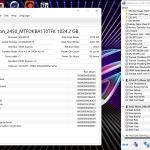Temperatures, Clocks, and Power
Looking at the chart for temperatures, power, and clocks gives us a good overview of how the Ryzen 9 6900HS processor behaves when loaded under the Performance power mode and without the dGPU.
We see the 35W-rated processor holding stable at its 45W power budget thanks to SmartShift Max. The corresponding clock speed is a highly stable 3.8GHz average across the eight-core chip, and this translates into a running temperature that settles a little over 80C.
AMD’s approach is to run clean, pure frequencies and power budgets for all-core loads. This differs to Intel’s approach that would see a huge spike in power for the early parts of the graph before eventually dropping down to a nominal 28W, 35W, or 45W or similar.
The key takeaway here is that ASUS’ cooling and power delivery does a superb job at allowing the AMD Ryzen 9 6900HS processor to run at a preferential clock speed and 45W TDP for extended time periods, without any throttling.
There’s a lot of untidy data in this scatter graph, and I will also point out that this data is mostly for reference usage as I only did one run and set of analysis here. Plus, there’s a slight timing difference between the GPU-Z and HWiNFO data, though this doesn’t affect the trend visualisations.
Effectively, what the data is showing is how the G14 operates under an extended gaming load.
The CPU package power reported looks to actually be more accurately displaying the CPU+dGPU power usage, presumably due to the way in which power is shared between the two under SmartShift Max. But reading between the mess of data, we see the CPU operate at around 15W of power eventually, which translates into around 2.7GHz average core frequency and an easy sub-80C temperature.
The GPU starts off at around 80W of power usage – its full TGP – when the system power budget is around 100W total. This GPU power allocation trends downwards, though, as the G14 sees restrictions applied to its running power. After more than 20 minutes of gaming, the GPU pulls around 55W of power and operates an average of around 1700-1750MHz core clock. GPU temperatures are absolutely fine at around high-70s.
With the system happy to deploy around 70W of power to the CPU and GPU after more than 20 minutes of F1 2020 gaming, ASUS seems to have been smart with the balance; 55W allocated to the GPU maintains lofty frequencies, while the CPU’s modest power allocation is fine thanks to Zen 3+’s excellent voltage scalability.
Noise
You can see an example of our noise testing result in the video review.
In our testing, the laptop ran at 48dBA whilst under sustained F1 2020 game loading. That was when measured by a sound meter at the trackpad. This seems perfectly reasonable in my opinion, especially for the horsepower squeezed into this compact form factor.
SSD
ASUS seems to have a passion for cheaping out and providing entry-level SSDs even in its expensive, high-end systems, which is highly disappointing.
There’s little to indicate that this Micron 2450 SSD actually benefits from its PCIe Gen 4×4 connection in terms of speed. And when additional games are loaded onto the drive, we noticed a significant drop in the write speeds as the buffer capacity is eaten into.
Battery
System runtime from the efficient AMD hardware and 76Whr battery is outstanding. We got around 10 hours of runtime in PCMark 10’s battery test, which should translate into about a dozen hours of reasonable system usage. If you want to do some stuff whilst at a solid day of work or on a long-haul flight, the G14 should have no issues powering that.
 KitGuru KitGuru.net – Tech News | Hardware News | Hardware Reviews | IOS | Mobile | Gaming | Graphics Cards
KitGuru KitGuru.net – Tech News | Hardware News | Hardware Reviews | IOS | Mobile | Gaming | Graphics Cards











